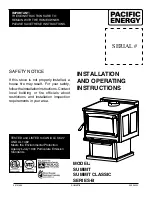
16
Stove Maintenance
Check stove regularly
Creosote: Formation and Need for Removal
When wood is burned slowly, it produces tar and other organic vapors, which combine with
expelled moisture to form creosote. The creosote vapors condense in the relatively cool
chimney flue of a slow-burning fire. If a significant layer of creosote has accumulated (3 mm or
more), it should be removed to reduce the risk of a chimney fire.
The chimney and chimney
connector should be inspected at least once every two months during the heating
season
to determine if a creosote buildup has occurred.
Initially, we recommend you check your flue system at least once per month
. After the first
few months you will notice a pattern of soot and creosote build-up and you can then determine
an inspection interval for checking soot and creosote build-up that is suitable for your stove
installation.
Other checks, as listed below, should be carried out at least twice per year
. If you notice
anything wrong, at any time, it should be repaired immediately. Never use a stove that is in any
way damaged or has a damaged flue.
1. Check your flue system for build-up of soot or creosote and for signs of damage to joints.
To check flue outlet, remove top of baffle by lifting and pulling out at end. Use a flashlight
to check flue outlet. Clean and repair as necessary. Always replace top baffle before
relighting stove.
2. Check that glass is not cracked or chipped and that sealing rope is in good condition.
Replace as necessary.
3. When the room is dark, use a strong flashlight to check the sealing of the stove at the
edge and corners for leaks. Any leaks or cracks found should be repaired with fire
cement or damaged parts should be replaced with genuine spare parts.
4. Check that stove door is tight and sealed well when closed. Place a strip of paper into
the stove and close the door. Try to pull out paper. You should feel some resistance to
your pull. Check several points around the door. If it pulls out too easily, replace the rope
and seal in place with a suitable high temperature sealant.
Care of fire bricks
Your stove comes with Fire Bricks lining the fire box. They serve as insulation as well as
protection to the cast iron or steel fire box. The fire bricks are quite delicate as compared to the
rest of your stove, so please keep this in mind when loading logs into the firebox. They will crack
and chip if not cared for properly. Fire bricks expand and become brittle when heated. Use
caution when cleaning the firebox and around the ash grate.
Do not try to pry off fire bricks
while cleaning as they will break. Damage caused by the mishandling of fire bricks will
not be covered under warranty.
Содержание HF-517U
Страница 4: ...3 Sample of Label...
Страница 14: ...13 Combustible Wall Chimney Connector Pass Throughs...
Страница 19: ...18 HF 517U Parts List...








































